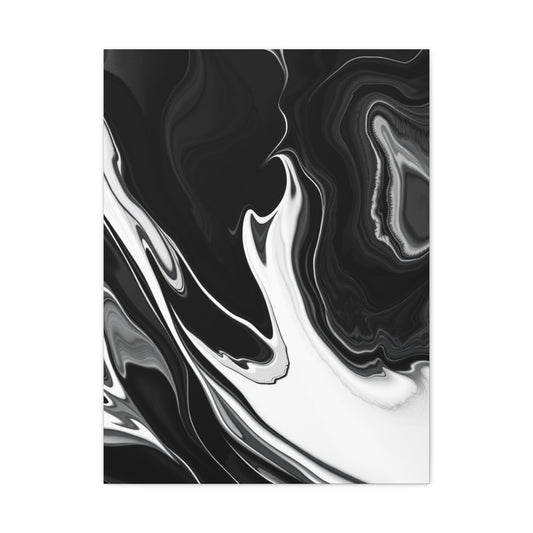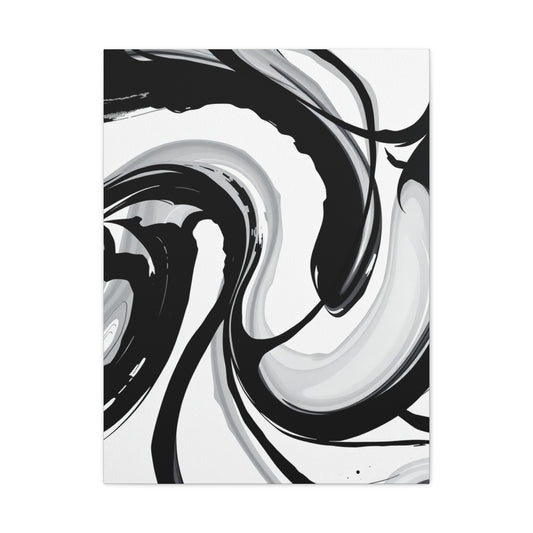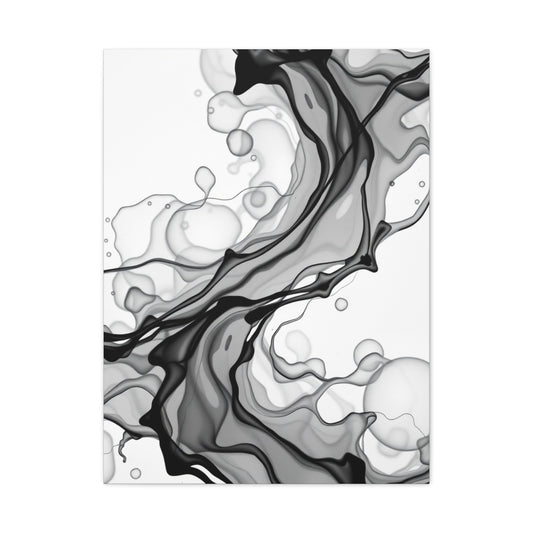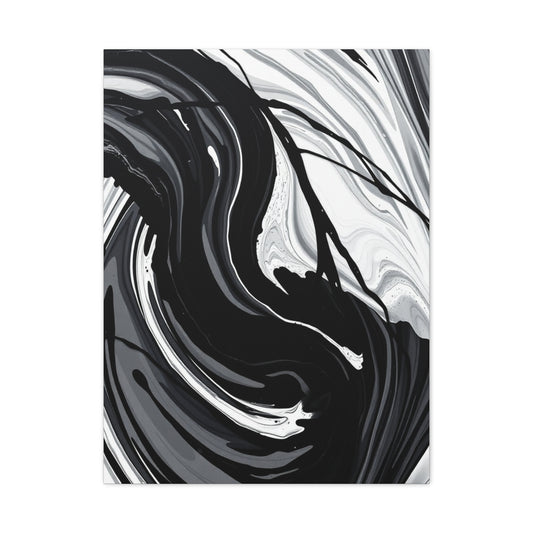Elevate Everyday Interiors with Striking Black and White Abstract Wall Art Designs
Black and white abstract art has a unique and timeless appeal that very few design elements can match. The simplicity of its palette—just two contrasting shades—creates a powerful visual statement that feels bold yet understated, modern yet classic. This duality is what makes monochrome abstract pieces such a versatile choice for everyday interiors. Whether displayed in a sleek urban apartment, a cozy family home, or even a professional office, black and white wall art instantly elevates the atmosphere, adding a layer of depth and sophistication.
One of the most compelling aspects of black and white abstract artwork is its ability to adapt without losing its impact. Unlike colorful pieces that can sometimes overwhelm a room or clash with existing décor, monochrome designs strike a delicate balance. They provide structure and elegance, while still allowing flexibility for furniture, textiles, or accent décor to shine. For example, a bold abstract piece with sweeping black lines on a white canvas can anchor a minimalist living room, while softer, textured monochrome patterns can add warmth and balance to a more eclectic setting.
Beyond aesthetics, black and white abstract art also enhances the emotional atmosphere of a space. Its stark contrasts evoke thought and curiosity, inviting viewers to interpret shapes, forms, and movement in their own unique way. This interpretive quality makes it more than just decoration—it becomes a conversation starter, a reflection of personal taste, and even a symbolic expression of identity. For those who value interiors that feel intentional and meaningful, monochrome art serves as both an artistic statement and a personal signature.
In addition, black and white art pairs seamlessly with various design styles. In modern interiors, it reinforces clean lines and sharp contrasts. In traditional homes, it provides a contemporary twist without disrupting classic charm. In industrial-style lofts, monochrome art emphasizes raw textures and urban aesthetics, while in bohemian or eclectic spaces, it creates balance amidst vibrant textiles and layered décor. The versatility is nearly limitless, making black and white abstract pieces an investment that remains relevant regardless of changing trends.
Ultimately, incorporating striking black and white abstract wall art into your interiors is more than a stylistic choice—it’s a way to transform everyday living spaces into curated environments that feel both artistic and personal. By striking the perfect harmony between simplicity and drama, these pieces breathe new life into interiors, proving that sometimes the most powerful designs emerge from the most minimal palettes.
Evolution of Modern and Contemporary Black and White Abstract Art
The story of black and white abstract art is one of constant reinvention, deeply rooted in the evolution of modernism yet still thriving in contemporary practice. While the history of abstract art as a whole reflects an ongoing dialogue between form, emotion, and innovation, the specific use of black and white holds a unique power. These two tones, stripped of the distraction of color, compel artists and audiences alike to focus on essentials—light, shadow, line, balance, and texture. What may seem simple at first glance often reveals itself as profoundly complex upon deeper engagement.
In the early 20th century, modernist pioneers began to challenge traditional notions of representation. Artists such as Kazimir Malevich with his iconic Black Square and Piet Mondrian with his geometric compositions demonstrated how limited palettes could provoke radical ideas. Their work stripped painting down to its bones, emphasizing rhythm, symmetry, and form in ways that continue to influence design and visual culture today. Black and white offered clarity, allowing artists to highlight the underlying structures of composition without the distractions of color psychology.
As the movement matured, mid-century abstract expressionists like Franz Kline embraced black and white with visceral energy. His bold, sweeping brushstrokes became synonymous with raw emotion, transforming simple hues into powerful visual statements. In these works, the absence of color became a statement of intensity, pushing the focus toward motion, gesture, and the immediacy of the creative act. For many, this marked a turning point where abstraction became more than an intellectual exercise—it became a visceral experience of presence and expression.
Contemporary black and white abstract art continues this exploration but pushes it further through new materials and experimental techniques. Artists today incorporate mixed media, digital layering, metallic accents, and even sculptural approaches to reimagine what abstract art can be. Textural contrasts—matte versus gloss, smooth versus rough—add another dimension to the interplay of black and white, creating depth and tactility that engages viewers on multiple levels. This evolution reflects both continuity with tradition and a fearless embrace of innovation.
For homeowners and collectors, black and white abstract pieces hold enduring appeal. Large-scale canvases filled with gestural marks, intricate ink drawings, or minimalist geometric patterns create striking focal points within interiors. Unlike representational art, which often dictates meaning, abstract compositions invite interpretation, sparking conversation and personal reflection. They adapt seamlessly to different design styles—from ultramodern lofts to classic spaces—because their timeless duality complements any palette.
Creative Inspirations and Process Behind Monochrome Abstract Art
The journey of creating black and white abstract art is often described by artists as both a meditative ritual and a technical challenge. Unlike colorful compositions, which can lean on vivid hues to convey emotion, monochrome abstracts depend entirely on form, contrast, and subtlety. This restriction pushes the artist to think differently, to experiment with texture, balance, and movement in ways that feel raw and authentic. For many creators, this process is not just about making art but about exploring inner thought, emotion, and the interplay between silence and expression.
One of the defining features of monochrome abstraction is its ability to strip away distraction. When the color spectrum is removed, what remains is a focus on the fundamentals—shape, line, and rhythm. Artists often find inspiration in the purity of simplicity, where every brushstroke holds weight and every area of negative space becomes as important as the painted forms themselves. The absence of color forces the viewer to slow down, to consider shadow and highlight, to read depth and emotion in the smallest tonal shifts. This dynamic makes black and white art both timeless and universally engaging.
The materials chosen by artists also play a vital role in shaping the creative process. Oil paints, with their slow-drying nature, allow for thick applications and layering, giving the painter room to experiment with texture and blending over extended sessions. Each layer can be revisited, reshaped, or built upon, offering a sense of fluidity and evolution. Acrylic paints, by contrast, dry quickly and respond to bold, gestural movements. Many artists working on large canvases appreciate acrylics for their immediacy, allowing them to capture bursts of energy and instinct before the emotion fades. Both mediums, though distinct, bring unique challenges that test an artist’s ability to balance freedom with restraint.
Inspiration for monochrome abstract work often stems from more than just aesthetics. Some artists are driven by architectural geometry, using sharp lines and precise structures to mirror the built environment. Others seek inspiration in nature, finding rhythm in waves, trees, or shifting landscapes but translating them into non-representational forms. Many describe the process as emotional release—painting not what they see, but what they feel. This gives the work a universal quality, allowing viewers to connect on their own terms. Each stroke, smudge, or wash of gray becomes an open-ended invitation for interpretation.
Emotional Resonance and Symbolism of Black and White Abstract Works
One of the most fascinating aspects of black and white abstract art is the profound emotional response it can generate within a space, particularly in living rooms where people gather to relax, converse, and reflect. These artworks rely not on a spectrum of colors but on the interplay of two powerful tones—black and white—that together embody universal contrasts found throughout human experience. Black is often viewed as mysterious, powerful, and grounding, carrying associations of strength, depth, and elegance. In contrast, white is linked to clarity, purity, openness, and serenity. When combined in a single piece of abstract art, they create a striking tension that speaks to the natural dualities of life: darkness and light, order and chaos, restraint and freedom.
This dynamic contrast is what makes black and white abstract paintings so compelling in living rooms. They serve as visual anchors, commanding attention without overwhelming the senses. Unlike colorful figurative artworks, which often deliver a direct narrative or recognizable subject, abstract compositions in black and white are deliberately ambiguous. Their meaning shifts with the viewer’s interpretation, allowing personal emotions and life experiences to shape the encounter. For instance, a thick, energetic black brushstroke cutting across a white canvas may inspire feelings of resilience and vitality in one observer, while another may interpret the same gesture as representing solitude, stillness, or even conflict.
The beauty of this interpretive openness lies in its inclusivity. Every household member or guest has the opportunity to engage with the artwork in their own way, discovering layers of meaning that may evolve over time. A piece that once felt bold and invigorating might, in a different mood or phase of life, seem calming and contemplative. This flexibility is one of the reasons black and white abstract art remains timeless—it adapts to both the environment and the emotional state of those who encounter it.
Why Black and White Abstract Art Makes a Striking Living Room Statement
Few décor elements possess the power to instantly redefine a living room quite like black and white abstract art. With its bold interplay of contrasting tones, this style of artwork introduces both drama and refinement into any setting. The absence of color shifts the focus toward composition, line, texture, and form, allowing each stroke or pattern to make a powerful visual impact. This striking simplicity creates a natural focal point, transforming blank walls into captivating design statements that invite conversation and contemplation.
One of the greatest strengths of black and white abstract art lies in its adaptability. Unlike colorful works that can sometimes compete with upholstery, rugs, or wall paint, monochrome art seamlessly integrates with a wide range of interiors. Whether your living room features a palette of vibrant jewel tones, earthy neutrals, or minimalist whites and greys, black and white art serves as a unifying anchor. Its neutrality ensures it never overwhelms the space, instead balancing the overall décor and complementing both modern and traditional furnishings.
Scale also plays a crucial role in amplifying its effect. A single large canvas featuring bold brushstrokes or geometric patterns can dominate the room, instantly establishing character and presence. Smaller, thoughtfully arranged pieces, on the other hand, can form a curated gallery wall that tells a unique visual story. Regardless of format, the clean lines and tonal contrasts of monochrome artwork create a sense of rhythm that enriches the atmosphere of the living space.
Another reason black and white abstract art stands out is its timeless quality. While design trends shift from year to year, the simplicity of monochrome never loses its relevance. Investing in a striking abstract piece means your artwork will remain stylish even as furniture styles, wall colors, or decorative accents change. It grows with the space, adapting effortlessly to evolving tastes and trends.
Beyond aesthetics, black and white abstract art carries an emotional depth. Black often conveys strength, elegance, and mystery, while white symbolizes purity, openness, and tranquility. Together, they capture the dualities of human experience—order and chaos, light and darkness, simplicity and complexity. This emotional resonance allows the artwork to be more than mere decoration; it becomes a reflection of personality and mood, shaping the way a living room feels to both residents and guests.
Selecting the Ideal Black and White Abstract Art for Your Home
Choosing the right black and white abstract artwork for your living space goes beyond simply picking something visually pleasing—it involves an intentional balance of size, placement, mood, and how the piece interacts with its environment. The beauty of monochrome art lies in its versatility; it can be bold and commanding or subtle and meditative, depending on how it is selected and displayed.
One of the first considerations is scale. A large, statement-making canvas above a sofa or bed can serve as the focal point of a room, grounding the space and adding drama. On the other hand, smaller artworks can be grouped together to form a cohesive gallery wall, creating rhythm and variety while still maintaining unity through their black-and-white palette. The size of the wall and the viewing distance matter greatly—too small a piece on a vast expanse of wall may feel underwhelming, while an oversized canvas in a compact area may overwhelm the room.
Another factor is the composition of the artwork itself. Black and white abstract pieces often explore contrasts between negative space and dense brushwork. A piece with bold, sweeping strokes can add movement and energy, making it ideal for lively communal spaces such as living rooms or dining areas. Conversely, more minimalist works with ample open space may be better suited for bedrooms or reading nooks, where calmness and serenity are desired.
Symmetry and asymmetry also play a role in selection. Symmetrical compositions can contribute to a sense of order and stability, harmonizing with rooms that already feature structured design elements. Asymmetrical designs, by contrast, bring dynamic tension and visual intrigue, which can invigorate modern, eclectic, or creatively styled interiors.
Framing choices further influence the final look. A sleek metal frame works well in modern, urban settings, enhancing the artwork’s crisp contrasts. In contrast, a natural wood frame can soften the edges and introduce warmth, making the artwork feel at home in rustic, bohemian, or transitional interiors. Some homeowners even opt for frameless canvases to emphasize a raw, contemporary aesthetic.
Finally, art should be personally meaningful. While design considerations are important, the emotional resonance of a piece ultimately determines whether it will enhance your home. Does the artwork make you pause and reflect? Does it spark curiosity, inspire calm, or echo your personality? The best black and white abstract art resonates on both an emotional and intellectual level, making your space feel curated and authentic.
By approaching your selection with thoughtfulness—considering scale, composition, framing, and emotional connection—you ensure your home feels deliberately designed rather than randomly decorated. The right monochrome abstract piece not only complements your space but also transforms it into a living reflection of your taste and character.
Minimalist Approaches in Monochrome Abstract Expression
Minimalist approaches in monochrome abstract art embody the essence of simplicity, restraint, and deliberate intention. By stripping away unnecessary elements, these works reveal the raw interplay between form and emptiness. In black and white minimalist art, negative space is not simply “empty”—it becomes an active participant, shaping how the eye perceives the entire composition. Expansive stretches of white or black are punctuated by carefully chosen strokes, textures, or geometric arrangements, producing an atmosphere that feels serene yet powerful. Unlike colorful or intricate artworks, monochrome minimalism asks the viewer to slow down, observe subtleties, and discover meaning in what at first appears deceptively simple.
The discipline of minimalist abstract art lies in its precision. Every line, mark, or brushstroke carries immense weight because there is no ornamentation to distract from its impact. A single misplaced gesture can disrupt the harmony, which is why these artworks demand intentionality from the artist. The philosophy behind minimalism often draws from principles of balance, meditation, and even Zen practices, where emptiness is celebrated as much as presence. The restrained palette of black and white further heightens this discipline, emphasizing structure, contrast, and rhythm instead of relying on color for emotional resonance.
In interior design, minimalist monochrome abstract works thrive in modern and contemporary living rooms. Their clean simplicity resonates with uncluttered spaces, creating a quiet but commanding focal point. A large black-and-white canvas above a sofa or fireplace can instantly anchor a room, while smaller minimalist prints arranged thoughtfully on a gallery wall can introduce rhythm and balance without overwhelming the environment. Their neutral tones allow them to complement a wide range of furniture styles and color schemes, making them versatile choices for homeowners who value both elegance and adaptability.
What makes these pieces particularly captivating is their emotional and psychological influence. Minimalist abstract art encourages reflection, calmness, and mindfulness. When strategically placed, it transforms a room into a meditative sanctuary, inviting the viewer to pause and contemplate. The absence of visual clutter allows the mind to breathe, which can be especially refreshing in today’s fast-paced, overstimulated world.
Ultimately, minimalist approaches in monochrome abstract expression prove that less can indeed be more. By embracing simplicity, they reveal depth, by reducing form, they amplify meaning, and by limiting color, they heighten emotion. These artworks are not merely decorative—they are experiences in perception, presence, and stillness, reminding us that beauty often lies in restraint.
Styling Techniques to Showcase Black and White Abstract Artwork
The way black and white abstract artwork is presented within a living room or any interior space has a profound influence on how it is perceived. Beyond the artistic value of the piece itself, its placement, framing, and surrounding environment can either elevate or diminish its presence. By thoughtfully applying styling techniques, homeowners can transform abstract art from a simple decorative feature into a commanding focal point that defines the room’s character and atmosphere.
One of the most effective approaches is strategic placement. Positioning a large black and white canvas on a central wall, such as above a sofa or fireplace, instantly establishes the artwork as the room’s visual anchor. This placement draws the eye upon entry and helps ground the rest of the décor. Alternatively, curating a collection of smaller artworks and arranging them in a grid or gallery-style layout creates rhythm, storytelling, and dynamic energy. Such groupings are ideal for homeowners who wish to display different artistic voices while maintaining a unified monochrome palette.
Another essential consideration is framing. Black and white abstract art often carries a raw, striking quality, so frames should complement rather than compete with the composition. Thin black, white, or natural wood frames tend to enhance the simplicity and elegance of the artwork, while floating frames can lend a modern, gallery-like appeal. The frame acts as a bridge between the art and the wall, ensuring a clean transition that emphasizes the piece without overshadowing it.
Equally important is lighting, which has the power to completely transform the perception of abstract art. Directional lighting, such as adjustable track fixtures or gallery-style spotlights, allows homeowners to highlight specific textures, brushstrokes, and tonal contrasts within the piece. This not only adds depth but also emphasizes the tactile nature of monochrome abstract works, which often rely on surface variations rather than color. Natural light can also be leveraged, but care must be taken to avoid glare or fading over time.
To fully integrate artwork into a space, styling with complementary accents is essential. Monochrome cushions, sculptural vases, metallic finishes, or textured throws can echo the visual language of the artwork, creating harmony throughout the room. These supporting elements ensure that the art does not appear isolated but instead becomes part of a cohesive design story. For example, pairing a bold black and white canvas with chrome lighting fixtures or minimalist furniture reinforces a contemporary aesthetic, while pairing it with natural textures like stone or wood balances stark contrasts with warmth.
Ultimately, showcasing black and white abstract artwork is about balance—between boldness and subtlety, prominence and cohesion. With careful attention to placement, framing, lighting, and complementary décor, homeowners can ensure that their chosen artwork not only enhances the living space but also reflects personal taste and elevates everyday interiors into curated, gallery-like experiences.
Building a Collection of Black and White Abstract Paintings
Building a collection of black and white abstract paintings is not just about decorating walls—it is a journey that blends aesthetics, personal meaning, and potential financial value. For many collectors, these works represent more than visual appeal; they embody timeless expression, cultural relevance, and even long-term investment opportunities. Unlike colorful art, black and white abstractions hold a universal appeal. Their stark contrasts and minimalist palettes allow them to adapt to almost any interior, making them versatile additions to both modern and traditional spaces.
One of the first considerations when collecting is authenticity. Serious buyers should always verify the provenance of a piece, whether it comes directly from an artist, a gallery, or a reputable dealer. Documentation such as certificates of authenticity, artist signatures, and gallery records not only ensures that the work is genuine but also adds to its resale value. This process is particularly important when acquiring works from emerging artists, as their recognition may grow over time, potentially increasing the value of their early creations.
Equally important is understanding the techniques and materials used. A collector who takes time to learn about an artist’s process—whether it involves layered oil textures, ink washes, or mixed media on canvas—develops a deeper connection to the work. This knowledge enriches the collecting experience, turning each piece into more than just decoration but rather a reflection of artistic thought and experimentation.
Proper framing and preservation also play a central role in protecting the collection. Professional framing with archival-quality mats and UV-protective glass not only enhances the artwork’s appearance but also safeguards it against deterioration. Climate control is another critical factor; maintaining stable indoor temperatures and avoiding excessive humidity prevents warping, cracking, or discoloration. Collectors may also rotate their displayed works periodically, both to preserve the integrity of the pieces and to keep their interiors feeling fresh and dynamic.
Perhaps the greatest joy in building a collection comes from the sense of legacy and individuality it creates. Every painting represents a moment of inspiration captured by the artist and a conscious choice by the collector. Over time, the collection itself becomes a narrative—a visual story of taste, passion, and cultural appreciation. Unlike mass-produced prints, original black and white abstract works carry an exclusivity that makes them both emotionally rewarding and intellectually stimulating.
Ultimately, assembling such a collection is not merely about ownership but about stewardship. Collectors preserve, protect, and showcase pieces that hold meaning for them today and significance for future generations. Whether motivated by investment, emotional connection, or the pursuit of beauty, those who curate a thoughtful collection of black and white abstract paintings find themselves enriched by an art form that is as enduring as it is expressive.
Proper Preservation and Maintenance for Longevity
Caring for black and white abstract paintings requires more than just appreciation—it demands mindful preservation practices that extend the life and brilliance of the artwork. One of the most important steps is controlling light exposure. Direct sunlight is particularly harmful, as ultraviolet (UV) rays can cause pigments to fade, paper to yellow, and even canvas fibers to weaken over time. For this reason, homeowners should avoid placing valuable artworks near windows or bright artificial light sources. If displaying in naturally lit spaces, investing in UV-protective glass or acrylic coverings adds an additional shield without detracting from the painting’s presence.
Dusting is another vital yet delicate process. Using a soft, natural-hair brush allows collectors to gently remove surface dust without scratching or abrading the artwork. Household cleaners or chemical sprays should always be avoided, as they may seep into pigments or varnish layers, causing permanent damage. For pieces with significant value, professional conservators can periodically inspect and clean the surface with specialized tools and techniques.
Humidity and temperature control also play a critical role in preservation. Oil-based paintings, for example, are especially vulnerable to warping or cracking when subjected to fluctuating moisture levels. Ideally, indoor humidity should remain steady between 40–55%, while avoiding extremes of dryness or dampness. Rooms with stable climate control—far from radiators, fireplaces, or damp basements—are ideal. For added security, rotating artworks periodically can reduce uneven fading or pressure on framing components, ensuring each piece ages gracefully.
By implementing these thoughtful measures, homeowners and collectors can safeguard the delicate beauty of their black and white abstract art. Such practices not only protect financial value but also preserve the emotional and cultural significance of each painting, allowing them to inspire new generations.
The Elegance and Enigma of Monochrome Expression
The enduring appeal of black and white abstract art comes from its ability to embody contrasts and contradictions. By stripping away the distraction of color, artists invite viewers into a world defined solely by form, texture, and rhythm. This absence of color does not result in a lack of expression; rather, it amplifies every brushstroke, gesture, and nuance. A sharp black line cutting across a blank white field might convey strength and authority, while the same mark softened by blending can evoke calm or introspection. The simplicity of monochrome actually heightens complexity, as each detail is magnified and left open to interpretation.
One of the reasons monochrome abstraction resonates so strongly is its timeless quality. While colorful works may be tied to particular trends or cultural associations, black and white abstracts remain enduring and universally relevant. A piece created decades ago can still feel modern today, just as a newly painted work can echo the elegance of early 20th-century modernism. This duality of being both historical and contemporary is what gives monochrome its enigmatic charm.
Versatility also plays a significant role in its appeal. A single painting can transform the character of a space. In a minimalist interior, a bold black and white canvas can act as the focal point, drawing the eye and defining the atmosphere. Conversely, in a richly decorated room filled with patterns and textures, the same piece can serve as a grounding element—balancing visual richness with restrained elegance. Unlike colorful works that may clash with shifting décor styles, monochrome compositions adapt seamlessly, complementing virtually any palette.
Beyond decoration, black and white abstracts serve as emotional companions within a home. Their layered meanings invite contemplation, often sparking different interpretations depending on mood and context. They can soothe during quiet evenings, ignite curiosity in conversation with guests, or offer moments of reflection when one seeks clarity. Their paradoxical nature—serene yet bold, minimal yet profound—creates a dynamic presence that evolves with time.
At its core, monochrome abstract art embodies both elegance and enigma. It thrives on contrasts: light and shadow, emptiness and form, clarity and mystery. This duality ensures its continued relevance, as each generation discovers new dimensions within its seemingly simple framework. More than just an aesthetic choice, black and white abstraction represents a dialogue between the artist, the viewer, and the surrounding environment—an ongoing conversation that never loses its ability to inspire, intrigue, and endure.
Conclusion:
Adding black and white abstract art to a living room is not just a matter of filling empty wall space—it is an intentional choice that shapes the character, energy, and emotional atmosphere of the home. These works go beyond aesthetics; they embody a philosophy of design that blends elegance with depth, simplicity with complexity. The absence of color invites viewers to focus on texture, movement, and form, transforming the artwork into a medium of reflection and storytelling. Each brushstroke captures raw emotion, while each composition invites endless interpretation. What one person sees as serenity, another may view as intensity. This subjectivity is what makes monochrome abstract art both personal and universal at once.
For many, these artworks evoke calmness, serving as visual anchors in spaces often filled with activity. For others, the same works ignite conversation, curiosity, and even bursts of energy. This adaptability makes black and white abstract art especially well-suited for living rooms, which are central gathering places for both family and guests. Unlike colorful pieces that may quickly fall out of harmony with shifting décor, monochrome compositions remain timeless. They complement evolving design choices—whether minimalist, industrial, modern, or eclectic—without losing their impact.
Scale also plays a major role in how black and white abstract art influences a space. A large canvas hung above a sofa can act as a commanding focal point, giving the room a sense of drama and cohesion. Minimalist works with clean lines and expansive negative space can bring tranquility and order, creating a meditative environment. Conversely, grouping several smaller pieces into a gallery-style arrangement allows homeowners to tell a story, weaving together different moods and artistic voices into a collective visual narrative. In each case, the artwork does more than decorate; it defines the rhythm of the room.
Beyond aesthetics, ownership of original abstract art holds lasting value. Collectors are not simply purchasing a painting; they are investing in culture and creativity. Supporting artists fosters innovation, allowing them to continue exploring new techniques and ideas that enrich society as a whole. Within the home, original works carry authenticity and originality that mass-produced prints cannot replicate. They become part of the homeowner’s story, reflecting taste, personality, and a commitment to meaningful expression. Over time, these pieces can also appreciate in financial value, especially when acquired from emerging artists whose reputations grow. Thus, collecting black and white abstract art is both a personal and cultural investment.
Preservation is equally important to ensure longevity. Proper framing with archival materials, UV-protective glass, and climate control safeguards the integrity of each piece. Dusting should be done gently with a soft brush, avoiding harsh cleaners that could damage delicate surfaces. Maintaining consistent indoor humidity prevents warping, cracking, or fading, ensuring that the artwork remains as powerful and vibrant for future generations as it is today. These measures transform the home into not just a decorated space, but a curated sanctuary of expression.
Ultimately, incorporating black and white abstract art into your living room is an embrace of contrast, balance, and interpretation. It acknowledges that art is not static decoration but a dynamic dialogue—between the artist and the viewer, the piece and the room, tradition and innovation. In a world often dominated by fleeting trends and visual noise, monochrome abstraction stands apart by offering stillness, sophistication, and timeless beauty.
By thoughtfully selecting and showcasing these works, you transform your living room into something more than functional. It becomes an environment infused with meaning, imagination, and elegance—one where every glance at the wall invites reflection, conversation, and connection. In this way, black and white abstract art is not just décor; it is an enduring presence that elevates everyday living into an experience of artful living.












